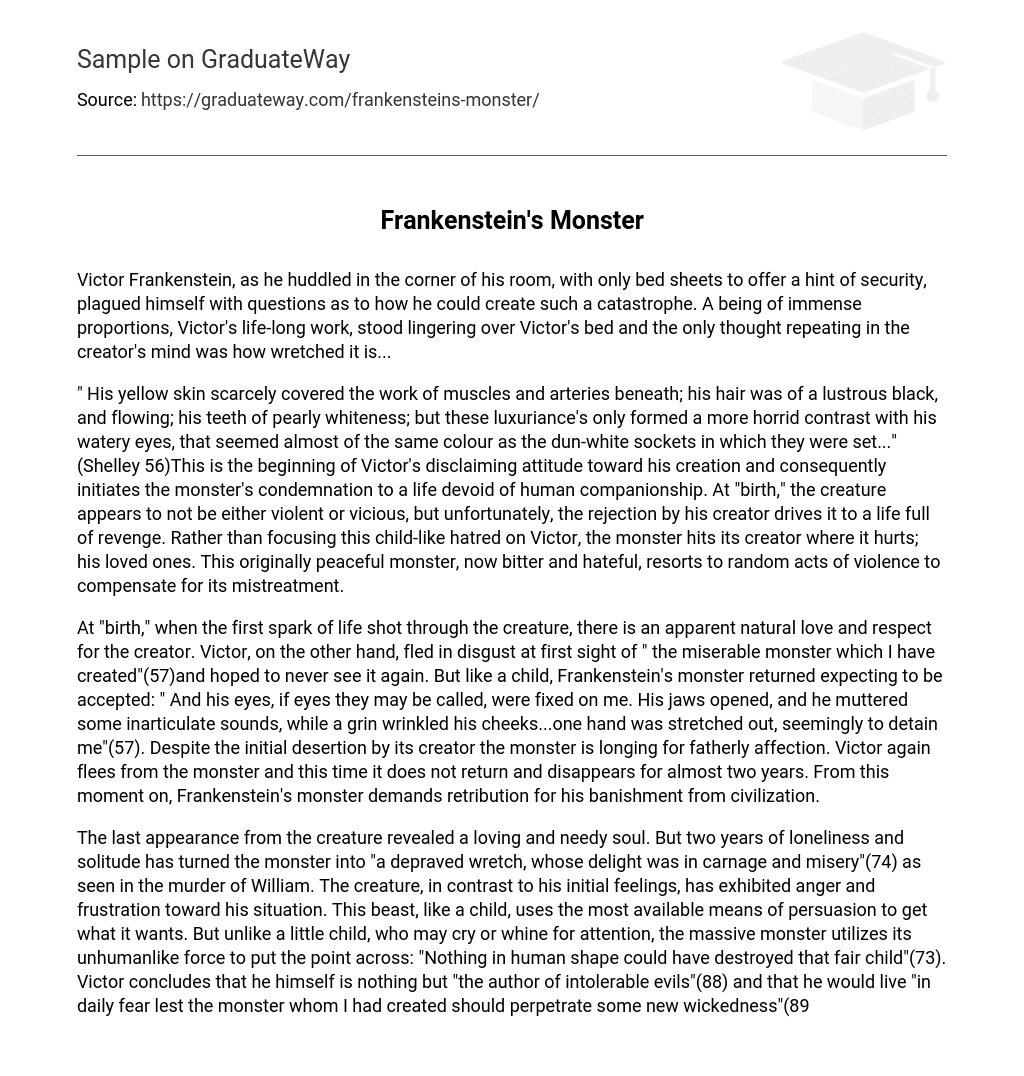Victor Frankenstein, as he huddled in the corner of his room, with only bed sheets to offer a hint of security, plagued himself with questions as to how he could create such a catastrophe. A being of immense proportions, Victor’s life-long work, stood lingering over Victor’s bed and the only thought repeating in the creator’s mind was how wretched it is…
” His yellow skin scarcely covered the work of muscles and arteries beneath; his hair was of a lustrous black, and flowing; his teeth of pearly whiteness; but these luxuriance’s only formed a more horrid contrast with his watery eyes, that seemed almost of the same colour as the dun-white sockets in which they were set…”(Shelley 56)This is the beginning of Victor’s disclaiming attitude toward his creation and consequently initiates the monster’s condemnation to a life devoid of human companionship. At “birth,” the creature appears to not be either violent or vicious, but unfortunately, the rejection by his creator drives it to a life full of revenge. Rather than focusing this child-like hatred on Victor, the monster hits its creator where it hurts; his loved ones. This originally peaceful monster, now bitter and hateful, resorts to random acts of violence to compensate for its mistreatment.
At “birth,” when the first spark of life shot through the creature, there is an apparent natural love and respect for the creator. Victor, on the other hand, fled in disgust at first sight of ” the miserable monster which I have created”(57)and hoped to never see it again. But like a child, Frankenstein’s monster returned expecting to be accepted: ” And his eyes, if eyes they may be called, were fixed on me. His jaws opened, and he muttered some inarticulate sounds, while a grin wrinkled his cheeks…one hand was stretched out, seemingly to detain me”(57). Despite the initial desertion by its creator the monster is longing for fatherly affection. Victor again flees from the monster and this time it does not return and disappears for almost two years. From this moment on, Frankenstein’s monster demands retribution for his banishment from civilization.
The last appearance from the creature revealed a loving and needy soul. But two years of loneliness and solitude has turned the monster into “a depraved wretch, whose delight was in carnage and misery”(74) as seen in the murder of William. The creature, in contrast to his initial feelings, has exhibited anger and frustration toward his situation. This beast, like a child, uses the most available means of persuasion to get what it wants. But unlike a little child, who may cry or whine for attention, the massive monster utilizes its unhumanlike force to put the point across: “Nothing in human shape could have destroyed that fair child”(73). Victor concludes that he himself is nothing but “the author of intolerable evils”(88) and that he would live “in daily fear lest the monster whom I had created should perpetrate some new wickedness”(89). Victor, as well as the reader, has a strong intuition that the monster will indeed commit additional monstrosities. William Frankenstein is only the beginning.
“Cursed, cursed creator! Why did I live? Why, in that instant did I not extinguish the spark of existence which you had so wantonly bestowed”(132). The monster, now totally rejected by man, has reached the point where life seems hopeless. Despite this, the creature does suggest a remedy for its brooding melancholy; a mate. ” I am malicious because I am miserable…and you my creator should pity me,”(140) is the excuse used by the beast and threatens to “work at your (Victor) destruction” and “desolate your heart, so that you shall curse the hour of your birth”(141) if Victor did not comply. Conscience overtakes Victor and he refuses to complete the task, knowing full well the monstrous hell that awaits him. This originally peaceful creature, Victor’s conception, now vows to fully unleash an unholy wrath on the creator’s life because “revenge remains – revenge…”(162).
“…But remember, I shall be with you on your wedding-night”(163). These words echo through Victor Frankenstein’s head, making him uneasy and spiteful towards the beast for being “the murderer of my peace”(163). But a deeper meaning lies behind this statement by the monster. The creature does in fact appear on Victor’s wedding night, but he is not the target, Elizabeth his wife is. The monster has administered complete revenge on Victor by eliminating the creator’s dearest love; “lifeless and inanimate…her bloodless arms and relaxed form flung by the murderer on its bridal brier”(189). This, consequently, is a parallel to the isolation from love bestowed on the monster.Frankenstein’s creation with its childlike emotions emerged as a tender being with no malice of thought. But the immediate feeling of rejection summoned anger in the beast that eventually wiped all joy out of its creator’s life. The monster, as birth, wanted nothing more than to be satisfied and loved. Yet, after all revenge had been played out, the creature felt a sense of fulfillment in accordance to its creator’s misery: “I am satisfied, miserable wretch! You have determined to live, and I am satisfied”(196), and with its revenge complete is “soon borne away by the waves and lost in darkness and distance”(215). Bibliography:





